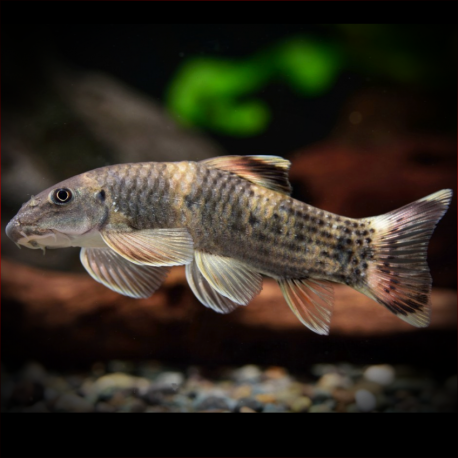More info
Datasheet
| Minimum Tank Size | 80 litres / 21.13 US gallons |
| Maximum Size | 9.0cm / 3.54inches |
| Temperature | 20°C / 68.00°F - 27°C / 80.60°F |
| Hardness | 2.02dgH / 36ppm - 12.05dgH / 215ppm |
| pH | 6.5-7.5 |
General Description
Garra Flavatra, commonly known as the Panda Garra, was first introduced to the aquarium trade in 2005 and quickly gained popularity. This species, belonging to the Cyprinidae family, exhibits a variety of color patterns with yellow and red pigmentation. It can be distinguished by its unique combination of physical characteristics, such as the presence of conical tubercles, two pairs of barbels, and specific scale counts in different body regions. The genus Garra, to which it belongs, is known for its enigmatic nature, with ongoing taxonomic revisions challenging existing classifications.
Aquarium Setup
Creating a suitable habitat for Garra Flavatra involves replicating a flowing stream or river environment within the aquarium. It is recommended to use variably-sized water-worn rocks, sand, fine gravel, and driftwood to mimic natural surroundings. Adding hardy aquatic plants like Microsorum and Anubias can enhance the setup. Maintaining clean, well-oxygenated water with a turnover rate exceeding 10 times per hour is crucial. Adequate lighting for biofilm development is necessary, and a secure cover is essential as this species can climb glass.
Behaviour
Panda Garra is generally peaceful but may display aggression towards similarly-shaped fish if kept alone. In the wild, they exist in loose aggregations and establish a pecking order within their group. Hierarchical disputes can occur among individuals, leading to behaviors like charging and flaring of fins. Maintaining a small group of 3-4 individuals is recommended to reduce intra-species aggression and promote a harmonious tank environment.
Feeding and Diet
While Panda Garra may graze on algae, they are not exclusive herbivores. A balanced diet should include meaty foods like chironomid larvae, Tubifex, Artemia, and chopped prawn. High-quality sinking dried foods containing vegetable matter, such as Spirulina, are also essential. Occasional offerings of fresh fruits, vegetables, and homemade gelatin-bound recipes can supplement their nutritional requirements.
Reproduction & Dimorphism
Successful breeding of Garra Flavatra has been achieved in captivity, with spawning occurring during the months of May to July. Males develop tubercules on the head and body, appearing slimmer compared to females. Breeding pairs are conditioned with specific foods, and the fry are raised on a diet starting from egg yolk suspension to Artemia nauplii. Flowing, oxygen-rich water is crucial for stimulating growth in the young.
Habitat and Distribution
Endemic to the Rakhine Yoma/Arakan mountain range in Myanmar, Panda Garra inhabits shallow streams with clear, slow-moving water. It prefers substrates of gravel, rocks, and pebbles, where it can find suitable conditions for foraging. The species' distribution may be wider than currently known, with some areas of its natural habitat remaining unexplored. Annual variations in water levels due to monsoon seasons influence their habitat preferences, emphasizing their adaptation to flowing waters.

